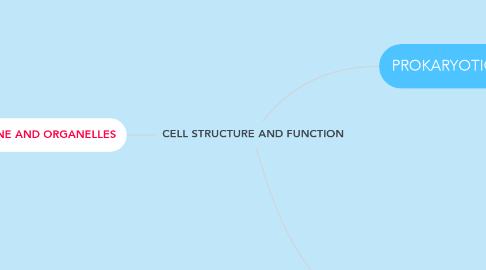
1. PROKARYOTIC & EUKARYOTIC
1.1. PROKARYOTE
1.1.1. Unicellular Org.
1.1.1.1. No Membrane Bound Organelles
1.1.1.2. Genetic material not enclosed by nuclear membrane
1.1.1.3. ✓Bacteria ✓Archaebacteria
1.2. EUKARYOTE
1.2.1. Multicellular Org.
1.2.1.1. Has Membrane Bound Organelles
1.2.1.2. Genetic material enclosed by nuclear membrane
1.2.1.3. ✓Protista ✓Fungi ✓Plants ✓Animals
2. PROKARYOTIC AND EUKARYOTIC CELL
2.1. PRINCIPLE OF CELL THEORY
2.1.1. ~Living Org.Composed Of Cells
2.1.2. Structural & Functional Unit Of All Org
2.1.3. Arise From Pre Existing Cells
3. CELL MEMBRANE AND ORGANELLES
3.1. Organelles
3.1.1. Nucleus
3.1.1.1. ✓Contain genetic material for inheritance ✓Allow substance &RNA to pass ✓site for rRNA synthesis
3.1.2. Ribosome
3.1.2.1. ✓site for protein synthesis ✓suspended freely in cytosol
3.1.3. Rough ER
3.1.3.1. Rib. synthesis protein | RER folds polypeptide into 3D shape | Packed into transport vesicle | Transported to GA
3.1.4. Smooth ER
3.1.4.1. ✓Synthesise lipids ✓Detoxification of drugs ✓Hydrolyse glycogen --> glucose ✓As sacroplasmic reticulum - store Ca+
3.1.5. Golgi apparatus
3.1.5.1. ~Modify,package and sorting of protein
3.1.5.2. Has cis & trans face
3.1.5.3. ~Form lysosome & polysaccharide
3.1.6. Lysosome
3.1.6.1. Involved in Food digestion,Autophagy,Autolysis
3.1.7. Mitochondrion
3.1.7.1. Site for cellular respiration
3.1.8. Chloroplast
3.1.8.1. Site for photosynthesis
3.1.9. Centrioles
3.1.9.1. Organize and form spindle fibre during cell division
3.2. Cell Membrane
3.2.1. FLUID MOSAIC MODEL
3.2.1.1. Fluid Characteristics
3.2.1.1.1. ✓Free to rotate ✓Move laterally
3.2.1.1.2. ✓Flip-flop
3.2.1.2. Mosaic Pattern
3.2.1.2.1. Arrangements of protein within phospholipid bilayer
3.2.1.3. Components
3.2.1.3.1. Phospholipid Bilayer
3.2.1.3.2. Channel Protein
3.2.1.3.3. Carrier protein
3.2.1.3.4. Membrane Protein
3.2.1.3.5. Cholesterol
3.2.1.3.6. Glycolipid
3.2.1.3.7. Glycoprotein
